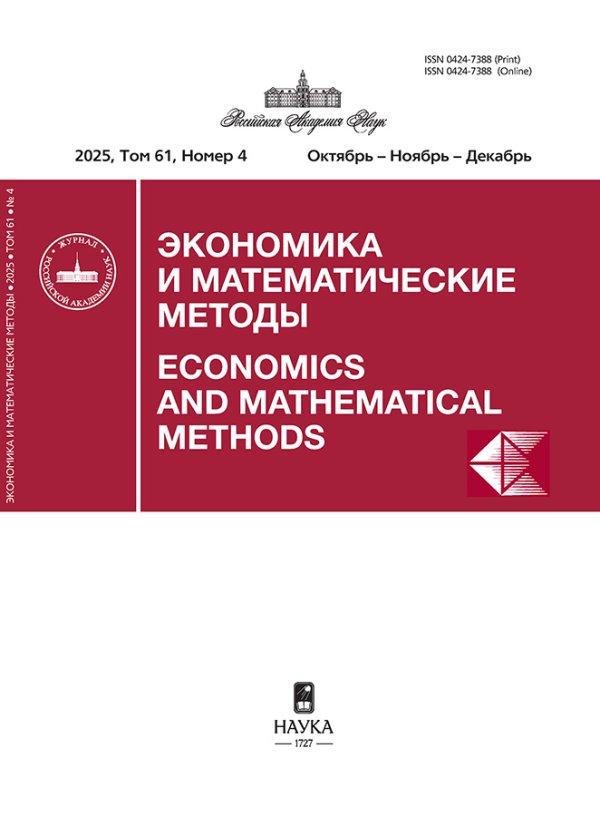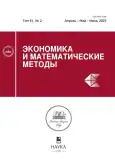Результативность основных информационных критериев при выборе лучшей модели краткосрочного экономического прогнозирования
- Авторы: Светуньков С.Г.1
-
Учреждения:
- Санкт-Петербургский политехнический университет Петра Великого
- Выпуск: Том 61, № 2 (2025)
- Страницы: 118-127
- Раздел: Математический анализ экономических моделей
- URL: https://vestnik.nvsu.ru/0424-7388/article/view/684539
- DOI: https://doi.org/10.31857/S0424738825020094
- ID: 684539
Цитировать
Полный текст
Аннотация
Любая теория базируется на некотором аксиоматическом ядре, в которое включаются аксиомы и постулаты. К последним относят выводы и результаты других теорий или разделов наук, которые в данной теории принимаются без доказательства. К таким постулатам, принятым в современном экономическом прогнозировании, относят информационные критерии, с помощью которых выбирают лучшую прогнозную модель из множества конкурирующих. Чаще всего прогнозисты используют два основных критерия — Акаике и Шварца. В статье на примере краткосрочного прогнозирования 120 различных рядов данных с помощью авторегрессий AR(p) показывается, что на практике этот инструмент работает не так хорошо, как ожидается. Альтернативой информационным критериям может выступить критерий, основанный на байесовской проверке гипотез, излагаемый в статье. Этот критерий включает информацию о правдоподобии описания априорных и апостериорных данных, перекрестный учет которых соответствует байесовскому выбору. Сравнительный анализ применения информационных критериев и нового критерия, результаты которого приведены в статье, свидетельствует в пользу последнего критерия, который и рекомендуется применять на практике.
Полный текст
Об авторах
С. Г. Светуньков
Санкт-Петербургский политехнический университет Петра Великого
Автор, ответственный за переписку.
Email: sergey@svetunkov.com
Россия, Санкт-Петербург
Список литературы
- Аистов А. В., Николаева Т. П. (2019). Гипотеза о стимулирующем воздействии туризма на ВВП // Прикладная эконометрика. Т. 56. С. 5–24. [Aistov A. V., Nikolaeva T. P. (2019). Hypothesis about the stimulating impact of tourism on GDP. Applied Econometrics, 56, 5–24 (in Russian).]
- Светуньков И. С., Светуньков С. Г. (2024). Методы и модели социально-экономического прогнозирования. Учебник и практикум для академического бакалавриата. Т. 1. «Теория и методология прогнозирования». М.: Издательство Юрайт. 351 с. [Svetunkov I. S., Svetunkov S. G. (2024). Methods and models of socio-economic forecasting. Textbook and practical training for the academic bachelor’s degree. Vol. 1. Theory and methodology of forecasting. Moscow: Yurait Publishing House. 351 p. (in Russian).]
- Светуньков С. Г. (2023). К вопросу о выборе лучшей прогнозной модели. В сб.: «Фундаментальные и прикладные исследования в области управления, экономики и торговли». Сборник трудов Всероссийской научно-практической и учебно-методической конференции. Санкт-Петербург, 15–19 мая 2023 года. Часть 2. С. 258–266. [Svetunkov S. G. (2023). On the issue of choosing the best forecast model. In: “Fundamental and applied research in management, economics and trade”. Collection of proceedings of the All-Russian scientific, practical and educational conference. St. Petersburg, May 15–19, 2023. Part 2, 258–266 (in Russian).]
- Тимофеев В. С., Фаддеенков А. В., Щеколдин В. Ю. (2015). Эконометрика. Учебник. Новосибирск: Изд-во НГТУ. 354 с. [Timofeev V. S., Faddeenkov A. V., Shchekoldin V.Yu. (2015). Econometrics: Textbook. Novosibirsk: NSTU Publishing House. 354 p. (in Russian).]
- Akaike H. (1974). A new look at the statistical model identification. IEEE Transactions on Automatic Control, 19, 6, 716–723.
- Akaike H. (1973). Information theory as an extension of the maximum likelihood principle. Second International Symposium on Information Theory. Edited by B. N. Petrov and F. Csaki. Budapest: Akademiai Kiado, 267–281.
- Berrar D. (2019). Cross-validation. In: “Encyclopedia of Bioinformatics and Computational Biology”. Reference module in Life Sciences, 1. Amsterdam: Elsevier, 542–545. doi: 10.1016/B978-0-12-809633-8.20349-X
- Degiannakis S., Filis G., Klein T., Walther T. (2022). Forecasting realized volatility of agricultural commodities. International Journal of Forecasting, 38, 1, 74–96.
- Emmert-Streib F., Liu J., Cherifi H., Kauffman S., Yli-Harja O. (2024). Moving beyond simulation and learning: Unveiling the potential of complexity data science. PLOS Complex Systems, 1 (2). doi: 10.1371/journal.pcsy.0000002
- Gilliand M. (2020). The value added by machine learning approaches in forecasting. International Journal of Forecasting, 36, 1, 161–166.
- Gold C. (2020). Fighting churn with data. N.Y.: Manning Publications. 504 p.
- Knafl G. J., Ding K. (2016). Adaptive regression for modeling nonlinear relationships. Springer International Publishing. 375 p.
- Knuppel M. (2014). Efficient estimation of forecast uncertainty based on recent forecast errors. International Journal of Forecasting, 30, 2, 257–267.
- Kolassa S. (2020). Will deep and machine learning solve our forecasting problems? Foresight, 57, Spring, 13–18.
- Makridakis S., Hibon M. (2000). The M3-competition: Results, conclusions and implications. International Journal of Forecasting, 16, 451–476.
- Mills T. C. (2019). Applied time series analysis: A practical guide to modeling and forecasting. London: Elsevier Science. 354 p.
- Ord K., Fildes R., Kourentzes N. (2017). Principles of business forecasting. N.Y.: Wessex Press, Inc. 544 p.
- Pritularga K. F., Svetunkov I., Kourentzes N. (2021). Stochastic coherency in forecast reconciliation. International Journal of Production Economics, 240 (7), 108221. doi: 10.1016/j.ijpe.2021.108221
- Schwarz G. (1978). Estimating the dimension of a model. The Annals of Statistics, 6, 2, 461–464.
- Shaikh A. A., Irfan Ali A. A., Cárdenas-Barrón L.E. (2021). Optimal decision making in operations research and statistics: Methodologies and applications. Abingdon: CRC Press. 434 p.
- Shittu O. I. (2009). Comparison of criteria for estimating the order of autoregressive process: A Monte Carlo approach. European Journal of Scientific Research, 30, 3, 409–416.
- Svetunkov S., Svetunkov I. (2024). On the issue of choosing the best predictive model based on Bayesian principles. In: T. C. Devezas, M. A. Berawi, S. E. Barykin, T. Kudryavtseva (eds.) “Understanding the digital transformation of socio-economic-technological systems. Lecture Notes in Networks and Systems”. Vol. 951. Cham: Springer. doi: 10.1007/978-3-031-56677-6_8
- Tallman E. W., Zaman S. (2017). Forecasting inflation: Phillips curve effects on services price measures. International Journal of Forecasting, 33, 2, 442–457.
- Weakliem D. L. (2016). Hypothesis testing and model selection in the social sciences. N.Y.: The Guilford Press. 202 p.
- Zhang J., Yang Y., Ding J. (2023). Information criteria for model selection. WIREs Computational Statistics, 15 (5), e1607. doi: 10.1002/wics.1607
Дополнительные файлы








